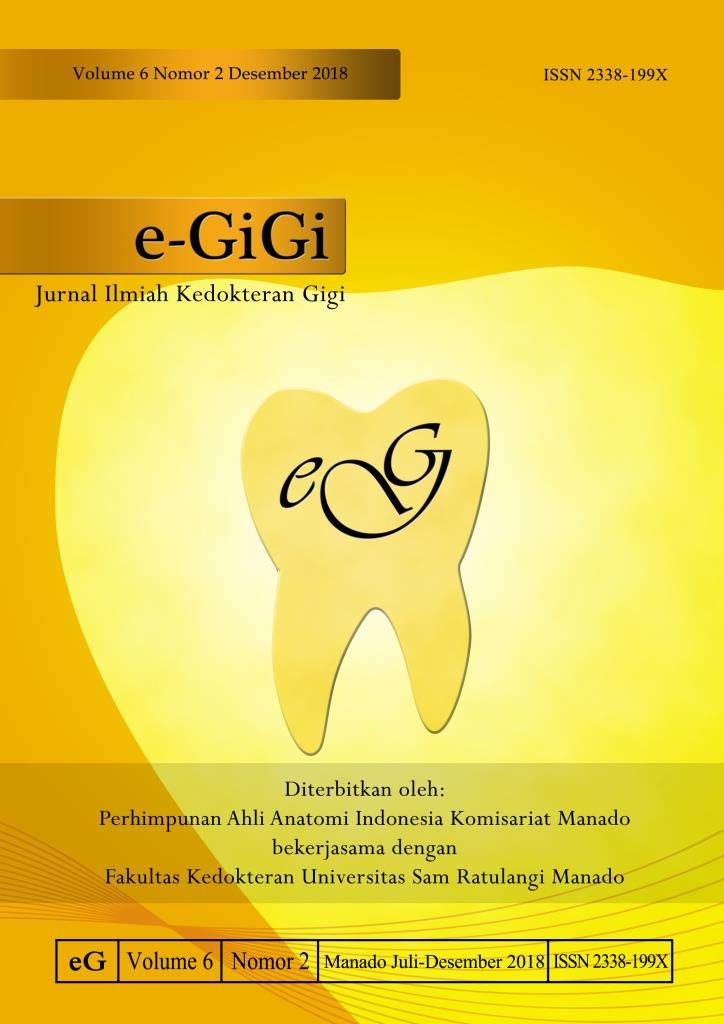Perbedaan Waktu Pembekuan Darah Pasca Pencabutan Gigi pada Pasien Menopause dan Non-menopause
DOI:
https://doi.org/10.35790/eg.6.2.2018.20953Abstract
Abstract: Entering the age of 40s in women, hormone levels and alveolar bone density begin to decrease which can cause wobbly teeth ended with tooth extraction. In menopausal patient, the tooth extraction has to be performed very carefully to avoid excessive bleeding. This study was aimed to compare the clotting time after tooth extraction of menopausal patients with of non-menopausal patients at RSGM Unsrat Manado. This was an analytical descriptive study with a cross sectional design. Study population included all female patients aged 35-60 years who had tooth extraction performed on them at the Oral Surgery Department of RSGM Unsrat in June 2018. Samples were obtained by using the total sampling method. The results showed that there were 32 subjects consisted of 13 women (40.63%) aged 35-44 years (non-menopause) and 19 women (59.37%) aged 45-60 tahun (menopause). Most of the normal clotting timess of non-menopausal subjects were at minutes-6 and 7, each of 5 subjects (15.62%). Most of the abnormal clotting times in menopausal subjects was at minute-9 as many as 8 subjects (25.00%). The Shapiro-Wilk test showed that data were not distributed normally; therefore, the further analysis was performed with the Mann-Whitney test with a P value of 0.000 (P <0.05). Conclusion: There was a significant difference in clotting time after tooth extraction between menopausal and non-menopausal patients.
Keywords: menopause, non menopause, clotting time, tooth extraction
Â
Abstrak: Memasuki usia 40-an kadar hormon pada perempuan mulai berkurang, demikian pula kepadatan tulang alveolar yang dapat menyebabkan kegoyangan gigi dan dilakukannya tindakan pencabutan gigi. Pada pasien menopause teknik pencabutan gigi harus dilakukan secara hati-hati untuk mengurangi risiko perdarahan berlebihan. Penelitian ini bertujuan untuk mengetahui perbedaan waktu pembekuan darah pasca pencabutan gigi antara pasien meno-pause dan non-menopause di RSGM Unsrat Manado. Jenis penelitian ialah deskriptif analitik dengan desain potong lintang. Populasi penelitian yaitu semua pasien perempuan berusia 35-60 tahun yang dilakukan tindakan pencabutan gigi di Bagian Bedah Mulut RSGM Unsrat pada bulan Juni 2018. Pengambilan sampel menggunakan metode total sampling. Hasil penelitian menda-patkan 32 orang subyek penelitian, terdiri dari 13 orang (40,63%) berusia 35-44 tahun (non-menopause) dan 19 orang (59,37%) berusia 45-60 tahun (menopause). Kategori waktu pembe-kuan normal pada subyek non-menopause terbanyak pada menit ke-6 dan ke-7, masing-masing sebanyak 5 orang (15,62%). Kategori tidak normal pada subyek menopause terbanyak pada menit ke-9 sebanyak 8 orang (25,00%). Hasil uji Shapiro-Wilk menunjukkan data terdistribusi tidak normal, dan dilanjutkan dengan uji Mann-Whitney dengan perolehan signifikansi 0,000 (P <0,05). Simpulan: Terdapat perbedaan bermakna pada waktu pembe-kuan darah pasca pencabutan gigi antara pasien menopause dan non menopause.
Kata kunci: menopause, non menopause, waktu pembekuan darah, pencabutan gigi
Downloads
How to Cite
Issue
Section
License
COPYRIGHT
Authors who publish with this journal agree to the following terms:
Authors hold their copyright and grant this journal the privilege of first publication, with the work simultaneously licensed under a Creative Commons Attribution License that permits others to impart the work with an acknowledgment of the work's origin and initial publication by this journal.
Authors can enter into separate or additional contractual arrangements for the non-exclusive distribution of the journal's published version of the work (for example, post it to an institutional repository or publish it in a book), with an acknowledgment of its underlying publication in this journal.
Authors are permitted and encouraged to post their work online (for example, in institutional repositories or on their website) as it can lead to productive exchanges, as well as earlier and greater citation of the published work (See The Effect of Open Access).






